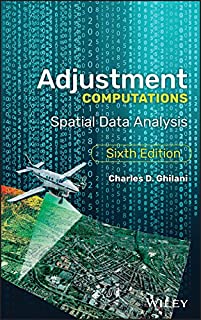Adjustment Computations Spatial Data Analysis 6 ed
Original price was: ₹14,895.74.₹11,916.59Current price is: ₹11,916.59.
ISBN: 9781119385981
Author/Editor: Charles D Ghilani
Publisher: John Wiley
Year: 2018
1 in stock (can be backordered)
Description
The definitive guide to bringing accuracy to measurement, updated and supplemented Adjustment Computations is the classic textbook for spatial information analysis and adjustment computations, providing clear, easy-to-understand instruction backed by real-world practicality. From the basic terms and fundamentals of errors to specific adjustment computations and spatial information analysis, this book covers the methodologies and tools that bring accuracy to surveying, GNSS, GIS, and other spatial technologies. Broad in scope yet rich in detail, the discussion avoids overly-complex theory in favor of practical techniques for students and professionals. This new sixth edition has been updated to align with the latest developments in this rapidly expanding field, and includes new video lessons and updated problems, including worked problems in STATS, MATRIX, ADJUST, and MathCAD. All measurement produces some amount of error; whether from human mistakes, instrumentation inaccuracy, or environmental features, these errors must be accounted and adjusted for when accuracy is critical.
Additional information
| Weight | 1.102 kg |
|---|
Product Properties
| Year of Publication | 2018 |
|---|---|
| Table of Contents | Preface xv Acknowledgments xix 1 Introduction 1 1.1 Introduction 1 1.2 Direct and Indirect Measurements 2 1.3 Measurement Error Sources 2 1.4 Definitions 3 1.5 Precision versus Accuracy 4 1.6 Redundant Observations in Surveying and Their Adjustment 7 1.7 Advantages of Least Squares Adjustment 8 1.8 Overview of the Book 10 Problems 10 2 Observations and Their Analysis 13 2.1 Introduction 13 2.2 Sample versus Population 13 2.3 Range and Median 14 2.4 Graphical Representation of Data 15 2.5 Numerical Methods of Describing Data 18 2.6 Measures of Central Tendency 18 2.7 Additional Definitions 19 2.8 Alternative Formula for Determining Variance 22 2.9 Numerical Examples 24 2.10 Root Mean Square Error and Mapping Standards 28 2.11 Derivation of the Sample Variance (Bessel's Correction) 31 2.12 Software 32 Problems 34 Practical Exercises 37 3 Random Error Theory 39 3.1 Introduction 39 3.2 Theory of Probability 39 3.3 Properties of the Normal Distribution Curve 42 3.4 Standard Normal Distribution Function 44 3.5 Probability of the Standard Error 47 3.6 Uses for Percent Errors 50 3.7 Practical Examples 50 Problems 53 Programming Problems 55 4 Confidence Intervals 57 4.1 Introduction 57 4.2 Distributions Used in Sampling Theory 59 4.3 Confidence Interval for the Mean: t Statistic 63 4.4 Testing the Validity of the Confidence Interval 66 4.5 Selecting a Sample Size 67 4.6 Confidence Interval for a Population Variance 68 4.7 Confidence Interval for the Ratio of Two Population Variances 70 4.8 Software 72 Problems 75 5 Statistical Testing 79 5.1 Hypothesis Testing 79 5.2 Systematic Development of a Test 82 5.3 Test of Hypothesis for the Population Mean 84 5.4 Test of Hypothesis for the Population Variance 85 5.5 Test of Hypothesis for the Ratio of Two Population Variances 89 5.6 Software 92 Problems 93 6 Propagation of Random Errors in Indirectly Measured Quantities 97 6.1 Basic Error Propagation Equation 97 6.2 Frequently Encountered Specific Functions 102 6.3 Numerical Examples 103 6.4 Software 107 6.5 Conclusions 109 Problems 109 Practical Exercises 112 7 Error Propagation in Angle and Distance Observations 113 7.1 Introduction 113 7.2 Error Sources in Horizontal Angles 113 7.3 Reading Errors 114 7.4 Pointing Errors 116 7.5 Estimated Pointing and Reading Errors with Total Stations 117 7.6 Target-Centering Errors 118 7.7 Instrument Centering Errors 120 7.8 Effects of Leveling Errors in Angle Observations 123 7.9 Numerical Example of Combined Error Propagation in a Single Horizontal Angle 126 7.10 Using Estimated Errors to Check Angular Misclosure in a Traverse 127 7.11 Errors in Astronomical Observations for Azimuth 130 7.12 Errors in Electronic Distance Observations 135 7.13 Centering Errors When Using Range Poles 136 7.14 Software 137 Problems 138 Programming Problems 141 8 Error Propagation in Traverse Surveys 143 8.1 Introduction 143 8.2 Derivation of Estimated Error in Latitude and Departure 144 8.3 Derivation of Estimated Standard Errors in Course Azimuths 146 8.4 Computing and Analyzing Polygon Traverse Misclosure Errors 146 8.5 Computing and Analyzing Link Traverse Misclosure Errors 152 8.6 Software 156 8.7 Conclusions 157 Problems 157 Programming Problems 161 9 Error Propagation in Elevation Determination 163 9.1 Introduction 163 9.2 Systematic Errors in Differential Leveling 163 9.3 Random Errors in Differential Leveling 166 9.4 Error Propagation in Trigonometric Leveling 171 Problems 174 Programming Problems 177 10 Weights of Observations 179 10.1 Introduction 179 10.2 Weighted Mean 181 10.3 Relationship Between Weights and Standard Errors 183 10.4 Statistics of Weighted Observations 184 10.5 Weights in Angle Observations 185 10.6 Weights in Differential Leveling 186 10.7 Practical Examples 187 Problems 190 11 Principles of Least Squares 193 11.1 Introduction 193 11.2 Fundamental Principle of Least Squares 194 11.3 The Fundamental Principle of Weighted Least Squares 196 11.4 The Stochastic Model 197 11.5 Functional Model 197 11.6 Observation Equations 199 11.7 Systematic Formulation of the Normal Equations 201 11.8 Tabular Formation of the Normal Equations 203 11.9 Using Matrices to Form the Normal Equations 204 11.10 Least Squares Solution of Nonlinear Systems 207 11.11 Least Squares Fit of Points to a Line or Curve 211 11.12 Calibration of an EDM Instrument 214 11.13 Least Squares Adjustment Using Conditional Equations 215 11.14 The Previous Example Using Observation Equations 217 11.15 Software 219 Problems 219 12 Adjustment of Level Nets 225 12.1 Introduction 225 12.2 Observation Equation 225 12.3 Unweighted Example 226 12.4 Weighted Example 229 12.5 Reference Standard Deviation 231 12.6 Another Weighted Adjustment 233 12.7 Software 236 Problems 238 Programming Problems 242 13 Precisions of Indirectly Determined Quantities 245 13.1 Introduction 245 13.2 Development of the Covariance Matrix 245 13.3 Numerical Examples 249 13.4 Standard Deviations of Computed Quantities 250 Problems 254 Programming Problems 256 14 Adjustment of Horizontal Surveys: Trilateration 257 14.1 Introduction 257 14.2 Distance Observation Equation 259 14.3 Trilateration Adjustment Example 261 14.4 Formulation of a Generalized Coefficient Matrix for a More Complex Network 268 14.5 Computer Solution of a Trilaterated Quadrilateral 269 14.6 Iteration Termination 273 14.7 Software 274 Problems 276 Programming Problems 282 15 Adjustment of Horizontal Surveys: Triangulation 283 15.1 Introduction 283 15.2 Azimuth Observation Equation 284 15.3 Angle Observation Equation 286 15.4 Adjustment of Intersections 288 15.5 Adjustment of Resections 293 15.6 Adjustment of Triangulated Quadrilaterals 298 Problems 303 Programming Problems 312 16 Adjustment of Horizontal Surveys: Traverses and Horizontal Networks 313 16.1 Introduction to Traverse Adjustments 313 16.2 Observation Equations 313 16.3 Redundant Equations 314 16.4 Numerical Example 315 16.5 Minimum Amount of Control 321 16.6 Adjustment of Networks 322 16.7 ?2 Test: Goodness of Fit 330 Problems 331 Programming Problems 342 17 Adjustment of GNSS Networks 343 17.1 Introduction 343 17.2 GNSS Observations 344 17.3 GNSS Errors and the Need for Adjustment 347 17.4 Reference Coordinate Systems for GNSS Observations 347 17.5 Converting Between the Terrestrial and Geodetic Coordinate Systems 350 17.6 Application of Least Squares in Processing GNSS Data 354 17.7 Network Preadjustment Data Analysis 356 17.8 Least Squares Adjustment of GNSS Networks 363 Problems 369 Programming Problems 386 18 Coordinate Transformations 389 18.1 Introduction 389 18.2 The Two-Dimensional Conformal Coordinate 389 18.3 Equation Development 390 18.4 Application of Least Squares 392 18.5 Two-Dimensional Affine Coordinate Transformation 395 18.6 The Two-Dimensional Projective Coordinate Transformation 398 18.7 Three-Dimensional Conformal Coordinate Transformation 401 18.8 Statistically Valid Parameters 407 Problems 411 Programming Problems 418 19 Error Ellipse 419 19.1 Introduction 419 19.2 Computation of Ellipse Orientation and Semiaxes 421 19.3 Example Problem of Standard Error Ellipse Calculations 426 19.4 Another Example Problem 428 19.5 The Error Ellipse Confidence Level 429 19.6 Error Ellipse Advantages 431 19.7 Other Measures of Station Uncertainty 435 Problems 441 Programming Problems 442 20 Constraint Equations 443 20.1 Introduction 443 20.2 Adjustment of Control Station Coordinates 443 20.3 Holding Control Station Coordinates and Directions of Lines Fixed in a Trilateration Adjustment 449 20.4 Helmert's Method 452 20.5 Redundancies in a Constrained Adjustment 458 20.6 Enforcing Constraints through Weighting 458 Problems 460 Practical Problems 463 21 Blunder Detection in Horizontal Networks 465 21.1 Introduction 465 21.2 A Priori Methods for Detecting Blunders in Observations 466 21.3 A Posteriori Blunder Detection 468 21.4 Development of the Covariance Matrix for the Residuals 470 21.5 Detection of Outliers in Observations: Data Snooping 472 21.6 Detection of Outliers in Observations: The Tau Criterion 474 21.7 Techniques Used in Adjusting Control 476 21.8 A Data Set with Blunders 477 21.9 Some Further Considerations 485 21.10 Survey Design 487 21.11 Software 489 Problems 490 Practical Problems 496 22 The General Least Squares Method and Its Application to Curve Fitting and Coordinate Transformations 497 22.1 Introduction to General Least Squares 497 22.2 General Least Squares Equations for Fitting a Straight Line 497 22.3 General Least Squares Solution 499 22.4 Two-Dimensional Coordinate Transformation by General Least Squares 503 22.5 Three-Dimensional Conformal Coordinate Transformation by General Least Squares 509 Problems 511 Programming Problems 515 23 Three-Dimensional Geodetic Network Adjustment 517 23.1 Introduction 517 23.2 Linearization of Equations 519 23.3 Minimum Number of Constraints 524 23.4 Example Adjustment 525 23.5 Building an Adjustment 533 23.6 Comments on Systematic Errors 534 23.7 Software 537 Problems 538 Programming Problems 543 24 Combining GNSS and Terrestrial Observations 545 24.1 Introduction 545 24.2 The Helmert Transformation 547 24.3 Rotations between Coordinate Systems 551 24.4 Combining GNSS Baseline Vectors with Traditional Observations 552 24.5 Another Approach to Transforming Coordinates between Reference Frames 556 24.6 Other Considerations 559 Problems 560 Programming Problems 563 25 Analysis of Adjustments 565 25.1 Introduction 565 25.2 Basic Concepts, Residuals, and the Normal Distribution 565 25.3 Goodness of Fit Test 568 25.4 Comparison of GNSS Residual Plots 572 25.5 Use of Statistical Blunder Detection 574 Problems 574 26 Computer Optimization 577 26.1 Introduction 577 26.2 Storage Optimization 578 26.3 Direct Formation of the Normal Equations 580 26.4 Cholesky Decomposition 581 26.5 Forward and Back Solutions 583 26.6 Using the Cholesky Factor to Find the Inverse of the Normal Matrix 584 26.7 Spareness and Optimization of the Normal Matrix 586 Problems 590 Programming Problems 590 Appendix A Introduction to Matrices 591 A.1 Introduction 591 A.2 Definition of a Matrix 591 A.3 Size or Dimensions of a Matrix 592 A.4 Types of Matrices 593 A.5 Matrix Equality 594 A.6 Addition or Subtraction of Matrices 595 A.7 Scalar Multiplication of a Matrix 595 A.8 Matrix Multiplication 595 A.9 Computer Algorithms for Matrix Operations 598 A.10 Use of the Matrix Software 601 Problems 603 Programming Problems 605 Appendix B Solution of Equations by Matrix Methods 607 B.1 Introduction 607 B.2 Inverse Matrix 607 B.3 The Inverse of a 2 x 2 Matrix 608 B.4 Inverses by Adjoints 610 B.5 Inverses by Elementary Row Transformations 611 B.6 Example Problem 616 Problems 617 Programming Problems 618 Appendix C Nonlinear Equations and Taylor's Theorem 619 C.1 Introduction 619 C.2 Taylor Series Linearization of Nonlinear Equations 619 C.3 Numerical Example 620 C.4 Using Matrices to Solve Nonlinear Equations 622 C.5 Simple Matrix Example 623 C.6 Practical Example 624 C.7 Concluding Remarks 626 Problems 627 Programming Problems 628 Appendix D The Normal Error Distribution Curve and Other Statistical Tables 629 D.1 Development for Normal Distribution Curve Equation 629 D.2 Other Statistical Tables 637 Appendix E Confidence Intervals for the Mean 649 Appendix F Map Projection Coordinate Systems 655 F.1 Introduction 655 F.2 Mathematics of the Lambert Conformal Conic Map Projection 657 F.3 Mathematics from the Transverse Mercator 659 F.4 Stereographic Map Projection 662 F.5 Reduction of Observations 663 Appendix G Companion Website 669 G.1 Introduction 669 G.2 File Formats and Memory Matters 670 G.3 Software 670 G.4 Using the Software as an Instructional Aid 674 Appendix H Answers to Selected Problems 675 Bibliography 681 Index 685 |
| Author | Charles D Ghilani |
| ISBN/ISSN | 9781119385981 |
| Binding | n/a |
| Edition | 1 |
| Publisher | John Wiley |
You must be logged in to post a review.






Reviews
There are no reviews yet.